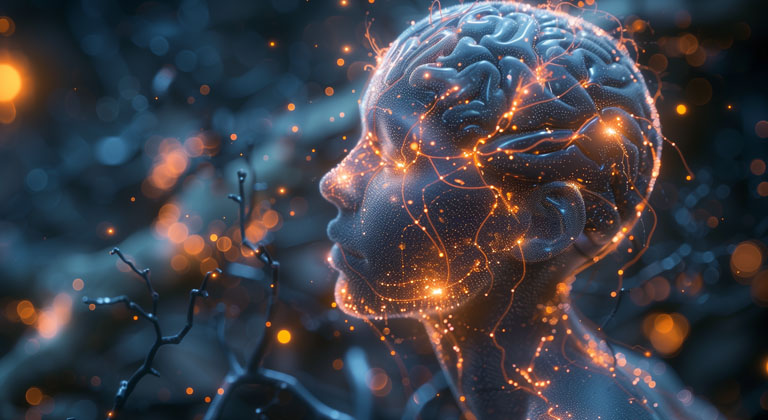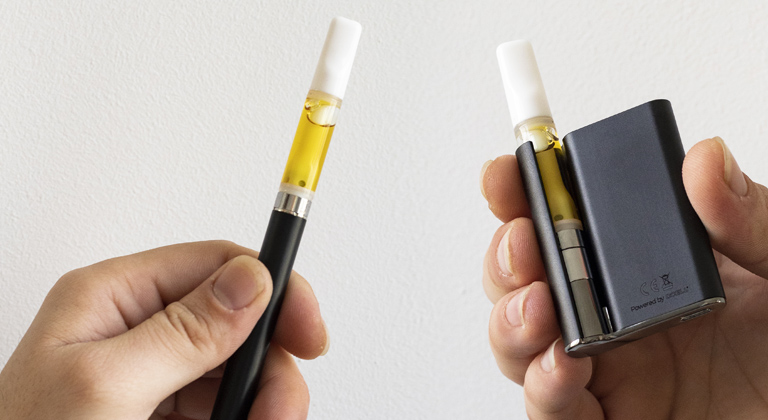Relationship between cannabis use and appetite
The cannabis plant is composed of various molecules, among which cannabinoids and terpenes stand out the most. From this first group, THC is the cannabinoid usually found in the highest quantity in cannabis, and it’s the compound responsible for its psychoactive effects.
However, as science advances in cannabis research, it is known that THC doesn’t only produce the euphoria associated with cannabis consumption. This cannabinoid is also useful for the treatment of certain diseases such as glioblastoma (a type of brain cancer), and also seems to be one of the reasons why we feel the desire to eat after using cannabis.
Several studies have shown that tetrahydrocannabinol interacts with the receptors of the endocannabinoid system, especially with the CB1 receptors located in the brain, which regulate different physiological functions, including the regulation of appetite.
How does THC act on our brain?
When we consume THC, this molecule binds to the receptors we’ve just mentioned located in the brain. Through this interaction, different chemical reactions are triggered, including the stimulation of appetite.
This is corroborated by a 2002 lab study on rats by Farrimond, Williams, and Kirkham (1). This research study showed that the animals considerably increased their intake of food after they were administered THC.
The researchers suggest that exogenously administered cannabinoids (meaning the molecules don’t come from our bodies but from the cannabis plant) promote eating by increasing the incentive value of food. What’s more, they also support the role of endocannabinoids (those produced by the body), in this case anandamide (a THC agonist) in the regulation of appetite and motivation to meet this physiological need.
Activation of neurons in the hypothalamus and increased appetite
The hypothalamic region of the brain is responsible for regulating several vital bodily functions, including appetite.
Neurons in this area (called Proopiomelanocortin or POMC) have a crucial role in the signaling of satiety. Normally, when these neurons are activated, we feel that we are full and have eaten enough.
A study on rats (2) found that the administration of THC affects the POMC neurons in the hypothalamus, significantly increasing their activity. Interestingly, one might think that, if they are responsible for “alerting” us to stop eating, the animals would show a reduction in their food intake when their activity is increased. However, the opposite occurred, as a significant increase in appetite was observed.
The researchers of this study used advanced imaging techniques to monitor the activation of these neurons in the hypothalamus in real time. What they found is that THC not only increased their activity (and, in turn, appetite), but also reduced the latency time to start intake, that is, the time the animals took to start eating.
These findings suggest that THC disrupts the normal signaling balance in the brain’s hypothalamus, increasing the production of neurotransmitters that stimulate appetite.
Another scientific study (3) revealed that the levels of endocannabinoids in the brain increase with food deprivation, and that blocking the receptors of the endocannabinoid system reduces appetite.
These findings indicate that the endocannabinoid system plays a very important role in the regulation of appetite, which opens the door for further exploration of the potential of cannabinoids in the treatment of feeding disorders and metabolic diseases.
In addition, these results help us better understand why cannabis produces the famous “munchies” effect.

Food becomes more appetizing: Increased sense of smell and taste after cannabis use
There isn’t a single reason for the “munchies.” This is a multifactorial phenomenon.
One of the reasons why we experience an increased appetite after using cannabis is because the senses of smell and taste are intensified, making food more attractive.
A study conducted in 2014 (4) showed that cannabinoids increase the sensitivity of smell through their action on the CB1 receptors of the olfactory bulb (located in the brain). Through this interaction, cannabinoids increase our ability to detect smells, producing a greater sense of excitement towards food.
Cannabis consumption increases ghrelin levels and promotes appetite
Ghrelin is a hormone that incites the desire to eat due to its effect in the hypothalamus, a region of the brain that, as explained above, is involved in the regulation of appetite.
Some research (5) suggests that cannabis consumption significantly increases ghrelin levels in the body, which is something that greatly contributes to the feeling of being hungry.
Ghrelin is commonly known as “the hunger hormone,” and it’s initially released into the stomach, from where it travels to the brain through the bloodstream. Once there, it acts on the region of the hypothalamus in order to induce appetite. This way, our body receives the signal that it needs to eat.
In a study conducted by Cumming et al. in 2001, ghrelin, insulin, and leptin levels were measured in plasma over 24 hours in individuals who received meals at a fixed schedule.
Through this trial, it was proven that ghrelin levels almost doubled before each intake, and decreased to minimum levels after eating, thus demonstrating the role of this hormone in the regulation of appetite.
These results laid the groundwork for other research study (6) to prove that cannabis use does intervene in the regulation of appetite by modifying the levels of these hormones.
To prove this, the study brought together 20 participants who used cannabis through different methods in different sessions:
- Orally
- Smoked
- Vaporized
Placebos were also administered (i.e., a formula without cannabis).
Blood samples were taken to measure the levels of ghrelin, leptin, GLP-1, and insulin after each session. The results of this trial revealed that:
- Blood insulin levels increased when participants consumed the placebo, as this was administered in the form of a brownie. However, this increase was lower when they actually used cannabis during the session.
- GLP-1: The concentrations of this hormone, which helps regulate appetite, were lower when the subjects used cannabis as opposed to the placebo.
- Ghrelin: The levels of this hormone were considerably higher after oral cannabis use, when compared to inhaled cannabis use.
With these findings, this study showed that cannabis use effectively modifies the levels of different hormones associated with appetite and metabolism. Understanding these mechanisms provides very useful information for the possible treatment of diseases related to these functions.

Cannabis and appetite: therapeutic prospects
The effect of cannabinoids on appetite modulation has significant implications in the medical field. This revealing information is very useful to understand the mechanisms that regulate this function, and can be applied in the treatment of the side effects of some treatments for cancer or HIV/AIDS, which can suppress the desire to eat.
Although further research is still needed to gauge the safety of long-term use of cannabis in this type of medical context, the findings of these studies provide evidence that cannabis may provide a way to improve the quality of life of those patients suffering from loss of appetite due to serious diseases.
Conclusion
The science behind the munchies reveals that this occurs through different mechanisms that impact our bodies through the endocannabinoid system. This is a process in which several factors come into play, including the activation of neurons in the hypothalamus, the increase in the sensitivity of smell and taste, and several endocrine hormones such as ghrelin.
Not only are these results interesting scientifically, but they can also pave the way for significant therapeutic applications, as cannabis could be a tool to alleviate the side effects of various diseases and treatments, with a higher safety profile than other drugs used in current medicine.
However, more research is still needed on this and other aspects of medical cannabis. In the meantime, we will continue to inform you about the latest advances on the subject.
1.Farrimond JA, Whalley BJ, Williams CM. A low-Δ9 tetrahydrocannabinol cannabis extract induces hyperphagia in rats. Behav Pharmacol. 2010 Dec;21(8):769-72. doi: 10.1097/FBP.0b013e328340a062. PMID: 20975531.
2. Koch, M., Varela, L., Kim, J. et al. Hypothalamic POMC neurons promote cannabinoid-induced feeding. Nature 519, 45–50 (2015). https://doi.org/10.1038/nature14260
3. Di Marzo, V., & Matias, I. (2005). Endocannabinoid control of food intake and energy balance. Nature Neuroscience, 8(585-589).
4. Soria-Gómez, E., Bellocchio, L., Reguero, L., Lepousez, G., Martin, C., Bendahmane, M., Ruehle, S., Remmers, F., Desprez, T., Matias, I., Wiesner, T., Cannich, A., Nissant, A., Wadleigh, A., Pape, H. C., Chiarlone, A., Quarta, C., Verrier, D., Vincent, P., … & Marsicano, G. (2014). The endocannabinoid system controls food intake via olfactory processes. Nature Neuroscience, 17(407-415). Ver estudio.
5. Cummings, D. E., Purnell, J. Q., Frayo, R. S., Schmidova, K., Wisse, B. E., & Weigle, D. S. (2001). A preprandial rise in plasma ghrelin levels suggests a role in meal initiation in humans. Diabetes, 50(8), 1714-1719.
6. Farokhnia M, McDiarmid GR, Newmeyer MN, Munjal V, Abulseoud OA, Huestis MA, Leggio L. Effects of oral, smoked, and vaporized cannabis on endocrine pathways related to appetite and metabolism: a randomized, double-blind, placebo-controlled, human laboratory study. Transl Psychiatry. 2020 Feb 19;10(1):71. doi: 10.1038/s41398-020-0756-3. PMID: 32075958; PMCID: PMC7031261.









